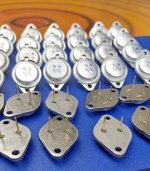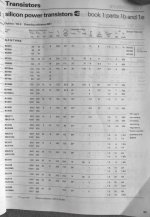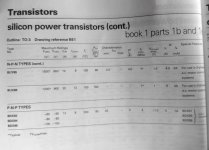According to wikipedia "The 2N3055 is a silicon NPN power transistor intended for general purpose applications. It was introduced in the early 1960s by RCA using a hometaxial power transistor process, transitioned to an epitaxial base in the mid-1970s"
The epitaxial process gave it a higher transition frequency which is arguably better for most applications.
What I am particularly interested in is the European sources of the 2N3055 in the transition period i.e the 1970s. Any information gratefully received.
Cheers
Ian
The epitaxial process gave it a higher transition frequency which is arguably better for most applications.
What I am particularly interested in is the European sources of the 2N3055 in the transition period i.e the 1970s. Any information gratefully received.
Cheers
Ian
Nice thread. I'll add a variant I've always wondered about: There used to be a 2N3055H, and I never found out what was different about it. I used to have some but I don't recall who made them (RCA or Motorola, probably?).
Anyone know?
Anyone know?
Those aluminum case TO-3s had a higher failure rate than steel. It seems the thermal expansion is higher than
steel and cracks the solder hoding the die. That casues more localized heating and it simply melts the silicon.
Later Motorola power transistors had steel cases.
G²
I did not say I want them. I am interested in who supplied them to European users in the 70s and how the specs changed over that period.Why you want 2n3055 from 70's?!
Those Motorola ones from 1969 in your picture - do you know if they were Motorola's own design or were they part of a mask exchange agreement for example?
Cheers
Ian
check out this thread:
https://www.diyaudio.com/community/...dels-quasi-complementary-power-output.157430/I am looking for the very first announcements and advertisements in electronic magazines so as brochure and application notes from RCA - go to post #144
Thank you very much for upload.
https://www.diyaudio.com/community/...dels-quasi-complementary-power-output.157430/I am looking for the very first announcements and advertisements in electronic magazines so as brochure and application notes from RCA - go to post #144
Thank you very much for upload.
Last edited:
How does this help me?You may have a look at Siemens BD130
Cheers
IAn
check out your last statement in post #1. The mentioned Siemens type (BD130Y) is one of the european versions of 2N3055 - also the KD503 from Tesla.
Certainly parameters are not identical to the genuine RCA versions.
Certainly parameters are not identical to the genuine RCA versions.
The oldest data book I found is to find in the PDF-URL from post #246 under
https://www.diyaudio.com/community/...asi-complementary-power-output.157430/page-13
https://www.diyaudio.com/community/...asi-complementary-power-output.157430/page-13
They had to be Motorola’s own design to meet “2N3055” specs. Moto never had a single diffused process (hometaxial is RCA’s version). I think Motorola introduced the epitaxial process as an alternative - but didn’t start getting really good with it till much later. Those old Motos couldnt hold a candle to RCA’s in anything except speed. Took a while to refine it to what they used the in the MJ15024 of the mid/late 80’s. They were a game changer then - rivaled only by the Japs, who had all the 20-30 MHz stuff that also had useable SOA for audio.Those Motorola ones from 1969 in your picture - do you know if they were Motorola's own design or were they part of a mask exchange agreement for example?
As early as the early seventies, all the major European manufacturers were offering 2N3055 second sources (labelled as such): Phillips, SSC, ITT, etc.
I must have an old Philips databook somewhere, already including a (succinct) datasheet of the 2N3055
I must have an old Philips databook somewhere, already including a (succinct) datasheet of the 2N3055
My apologies I should have been more precise. I am only interested in devices marked 2N3055 that were available in Europe throughout the 70s.check out your last statement in post #1. The mentioned Siemens type (BD130Y) is one of the european versions of 2N3055 - also the KD503 from Tesla.
Certainly parameters are not identical to the genuine RCA versions.
Cheers
Ian
So is it probable that all Motorola 2N3055s from the mid 1970s had a higher transition frequency than the RCA hometaxials?They had to be Motorola’s own design to meet “2N3055” specs. Moto never had a single diffused process (hometaxial is RCA’s version). I think Motorola introduced the epitaxial process as an alternative - but didn’t start getting really good with it till much later. Those old Motos couldnt hold a candle to RCA’s in anything except speed. Took a while to refine it to what they used the in the MJ15024 of the mid/late 80’s. They were a game changer then - rivaled only by the Japs, who had all the 20-30 MHz stuff that also had useable SOA for audio.
Cheers
Ian
I know that with common ICs, mask exchange agreements became the norm but was that done at the single transistor level of did each manufacturer design their own version of the 2N3055 from the ground up?As early as the early seventies, all the major European manufacturers were offering 2N3055 second sources (labelled as such): Phillips, SSC, ITT, etc.
I must have an old Philips databook somewhere, already including a (succinct) datasheet of the 2N3055
Cheers
Ian
At that time there was present three price ranges for the 2N3055 in the old catalogues from 70s from Conrad, Völkner, RIM and other suppliers:My apologies I should have been more precise. I am only interested in devices marked 2N3055 that were available in Europe throughout the 70s.
Cheers
Ian
1) Motorola (Now OnSemi) - most expensive (mostly above RCA, as I recall right)
2) Other branded versions like SGS/ATES, Valvo, Siemens, TFK, ITT etc. - a little cheaper
3) not branded versions (i. e. without logo) - cheapest available versions.
In retrospective also at those days issues like mentioned under
https://www.diyaudio.com/community/threads/counterfeit-transistors.115281/https://www.diyaudio.com/community/threads/my-transistors-original-or-copy.82638/probably was already present, especially in case of the brands like MOT and RCA.
Yes. Almost everything did, except for other manufacturers which were using processes similar to the RCA hometaxial. I’m sure the patent is expired now but it wasn’t then. Other makers did use super rugged but highly variable and not necessarily high yielding single diffused processes (including Toshiba, look at the data books for some of their 2SD100-era stuff) but they couldn’t call it by that name.So is it probable that all Motorola 2N3055s from the mid 1970s had a higher transition frequency than the RCA hometaxials?
Cheers
Ian
- Home
- Design & Build
- Parts
- 2N3055 the early years


